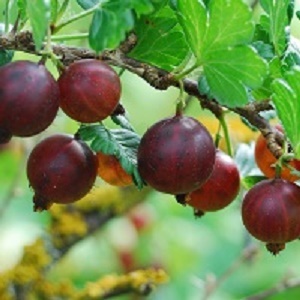Gooseberry : RED JOSTABERRY 2 year old plant
$27.95
ORDER NOW to guarantee this year's pricing on all our products!
Gooseberry x Current Cross
JOSTABERRY (Ribes nidigrolaria)
The word 'Jostaberry' was coined in the late 1950s by the German scientist Rudolph Bauer, who succeeded in creating a currant/gooseberry cross. He took the first few letters of both German names and combined them - hence Johannisbeere (currant) and Stachelbeere (gooseberry) became Jostaberry. The fruit itself combines some of the better qualities of both, yet somehow still remains quite uncommon outside of Europe.
Very similar to the Black Jostaberry – the deep, dark red berries are milder which enhances their fresh eating appeal. Just slightly. According to some sources the Red Jostaberry bush is the more productive one. Offset the reds and blacks for an effective and functional fruiting hedge.
SELF-FERTILE | ZONE 4 | HARVEST: MID-LATE JULY
Growing Tips
Are the leaves disappearing on your currant or gooseberry bush in early summer? Most likely the currant sawfly larvae are at work. The British have a simple prevention that works surprisingly well. Spread a thin layer of wood ashes around the base of the shrub. Some local gardeners use straw and claim it works better yet.
Try Lee Reich's simple recipe for powdery mildew control in grapes or gooseberries. Spray plants with the following:
4 litres (1 gallon) of water
1 tablespoon sodium bicarbonate (baking soda)
1 tablespoon canola oil
Repeated applications may be needed, especially in rainy weather.

5 reviews for Gooseberry : RED JOSTABERRY 2 year old plant
Only logged in customers who have purchased this product may leave a review.




Heidi Smithson (verified owner) –
Tracy (verified owner) –
Nice perky plant arrived on time, was planted and is flourishing. Hoping for delicious josta berries in the future!
Alvan B. (verified owner) –
Steve Nantel (verified owner) –
Ed Taves (verified owner) –
Plants great, well packed.